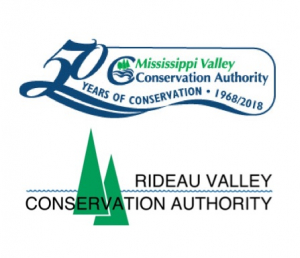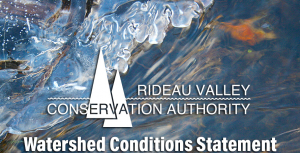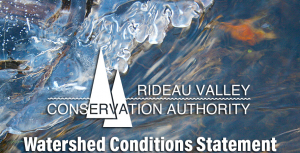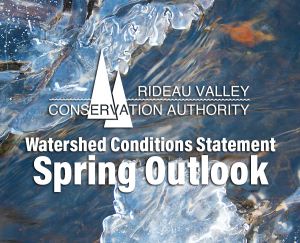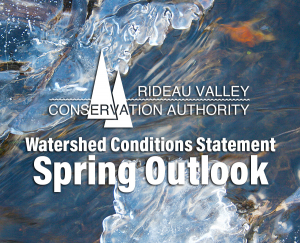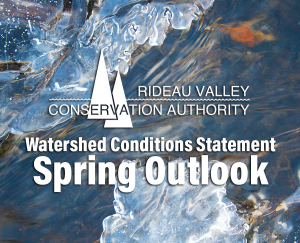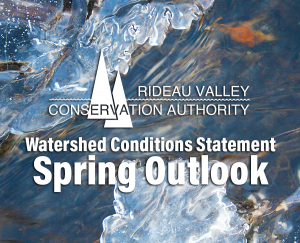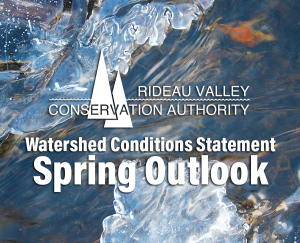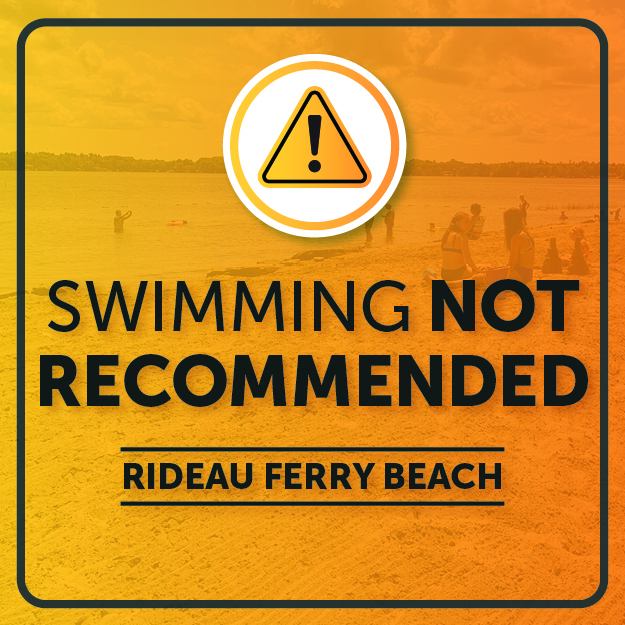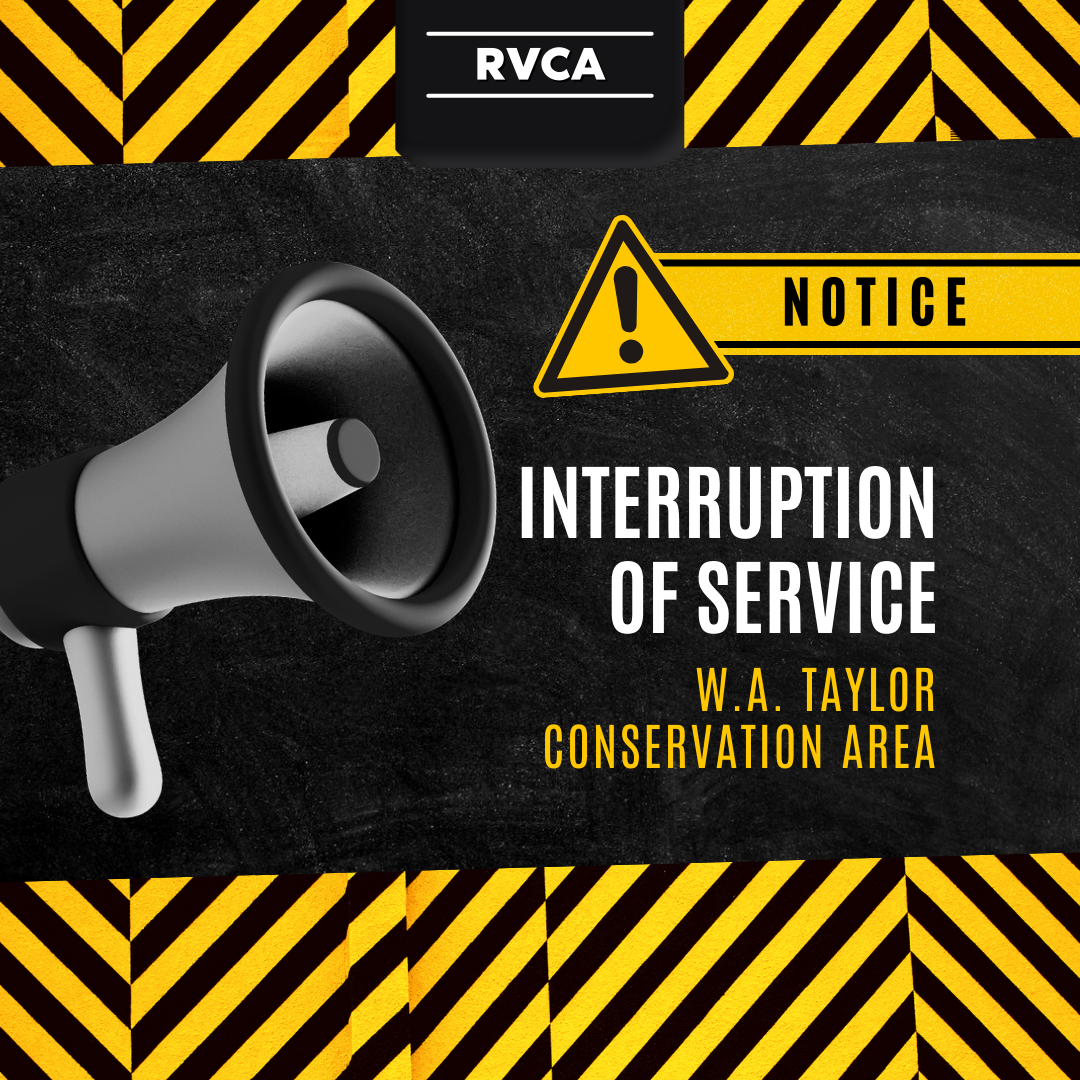Super User
Flood Outlook — Ottawa River – Constance Bay
MAY 1, Ottawa River – Constance Bay Area — Further to the press release issued by the Ottawa River Planning Board, the Mississippi Valley Conservation Authority is issuing a Flood Outlook for the Lac Deschene (Constance Bay, Britannia Bay) area of the Ottawa River watershed.
Levels and flows along the Ottawa River have started to increase with the onset of the spring freshet period. Based on the current snowpack and the weather forecast, levels and flows from Arnprior to Deschenes Rapids are expected to remain within the normal range of fluctuations associated with this time of year; however the normal range may be slightly exceeded. Model outputs currently indicate that levels are expected to increase of 50 to 60 cm over the next week and peak on or about May 7th, 2018. Given the size of the Ottawa River basin and forecasted rain over the next week, these predictions could change quickly and significantly.
Levels and flows along the Ottawa River have started to increase with the onset of the spring freshet period. Based on the current snowpack and the weather forecast, levels and flows are expected to remain within the normal range of fluctuations associated with this period of the year.
Residents are strongly urged to remind children of the dangers of hypothermia from cold water and playing near fast flowing rivers and creeks.
Residents in low lying areas, historically susceptible to flooding, should take the necessary precautions to protect their property, such as:
• Ensuring sump pumps are clear and in good working condition
• Removing or securing items that might float away as flows increase
This Watershed Conditions Statement is valid through May 7, 2018. Additional statements will be issued when or if conditions are expected to change significantly from this outlook.
Daily water levels and flows are available on the MVCA website at http://mvc.on.ca/water-levels/
The Mississippi Valley Conservation Authority flood forecasting and warning program monitors weather conditions, snowpack water content, estimates expected river flows and water levels and issues flood advisories or warnings as required. MVCA provides early warning and continuous monitoring to municipal and provincial emergency response personnel through a flood event.
April 30, 2018 – This message is to update the status of flood conditions in the Rideau River watershed.
No flooding is expected in the lower reaches of the system downstream of Smiths Falls although water levels can be expected to increase with rain forecast over the latter half of this week.
Bobs and Christie Lakes continue to be at risk for flooding. Higher levels on Christie Lake in particular can be expected as necessary releases are made to control levels on Bobs. No rain today or Tuesday will help but, if rain forecast for Wednesday and beyond is received, levels on both lakes can be expected to increase again.
Similar conditions may be occurring on other lakes in the area and residents should take precautions to ensure the security of their properties.
Note that streambanks are slippery and any remaining ice cover on streams, ponds and lakes will be hazardous. Children and pets should be kept away from all watercourses as levels fluctuate with the spring weather.
April 30, 2018 – This message is to update the status of flood conditions in the Rideau River watershed.
No flooding is expected in the lower reaches of the system downstream of Smiths Falls although water levels can be expected to increase with rain forecast over the latter half of this week.
Bobs and Christie Lakes continue to be at risk for flooding. Higher levels on Christie Lake in particular can be expected as necessary releases are made to control levels on Bobs. No rain today or Tuesday will help but, if rain forecast for Wednesday and beyond is received, levels on both lakes can be expected to increase again.
Similar conditions may be occurring on other lakes in the area and residents should take precautions to ensure the security of their properties.
Note that streambanks are slippery and any remaining ice cover on streams, ponds and lakes will be hazardous. Children and pets should be kept away from all watercourses as levels fluctuate with the spring weather.
Lakes in Upper Rideau Watershed Reaching Flood Level
April 28, 2018 – This message is specific to Bobs and Christie Lakes but may apply to other lakes in the area where remotely accessible monitoring equipment is not installed. Property owners are advised to go to their cottage properties and assess conditions for themselves.
Rain overnight has caused levels on Bobs and Christie Lakes to increase to flood levels. Additional rain forecast for today (Saturday) and Sunday will cause further increases. Some relief is expected on Monday and Tuesday. More rain is forecast for later in the week that will slow the decline on both lakes.
Levels of Bobs and Christie Lakes are being monitored closely by Parks Canada staff and operation of the dam at Bolingbroke will be done as required to minimize impacts on the two lakes.
Note that streambanks are slippery and any remaining ice cover on streams, ponds and lakes will be hazardous. Children and pets should be kept away from all watercourses as levels fluctuate with the spring weather.
Lakes in Upper Rideau Watershed Reaching Flood Level
April 28, 2018 – This message is specific to Bobs and Christie Lakes but may apply to other lakes in the area where remotely accessible monitoring equipment is not installed. Property owners are advised to go to their cottage properties and assess conditions for themselves.
Rain overnight has caused levels on Bobs and Christie Lakes to increase to flood levels. Additional rain forecast for today (Saturday) and Sunday will cause further increases. Some relief is expected on Monday and Tuesday. More rain is forecast for later in the week that will slow the decline on both lakes.
Levels of Bobs and Christie Lakes are being monitored closely by Parks Canada staff and operation of the dam at Bolingbroke will be done as required to minimize impacts on the two lakes.
Note that streambanks are slippery and any remaining ice cover on streams, ponds and lakes will be hazardous. Children and pets should be kept away from all watercourses as levels fluctuate with the spring weather.
More Rain Expected to Raise Water Levels Again
April 24, 2018 – Water levels are expected to rise again in the Rideau River watershed as a result of meltwater from the last of the snow, flow from thawing soil and rain forecast for Wednesday and Thursday.
Daytime temperatures are expected to approach 20 degrees over the rest of the week and stay above freezing at night. This will cause the remaining snow in the upper watershed to melt and, along with thawing water from the soil, begin to work its way down through the system. Rain in the order of 20 to 30 millimetres is forecast for the next two days which, in combination with the melt runoff, can be expected to cause water levels to rise.
Flooding is not expected but the levels of Bobs and Christie Lakes are being monitored closely by Parks Canada staff and operation of the dam at Bolingbroke will be done as warranted to minimize any impacts on the two lakes.
Access issues in the low-lying communities on the Long Reach of the Rideau between Kars and Kemptville such as Hilly Lane and Cedar Beach could occur as a result of the increasing flows.
Note that streambanks are slippery and any remaining ice cover on streams, ponds and lakes will be hazardous. Children and pets should be kept away from all watercourses as levels fluctuate with the spring weather.
More Rain Expected to Raise Water Levels Again
April 24, 2018 – Water levels are expected to rise again in the Rideau River watershed as a result of meltwater from the last of the snow, flow from thawing soil and rain forecast for Wednesday and Thursday.
Daytime temperatures are expected to approach 20 degrees over the rest of the week and stay above freezing at night. This will cause the remaining snow in the upper watershed to melt and, along with thawing water from the soil, begin to work its way down through the system. Rain in the order of 20 to 30 millimetres is forecast for the next two days which, in combination with the melt runoff, can be expected to cause water levels to rise.
Flooding is not expected but the levels of Bobs and Christie Lakes are being monitored closely by Parks Canada staff and operation of the dam at Bolingbroke will be done as warranted to minimize any impacts on the two lakes.
Access issues in the low-lying communities on the Long Reach of the Rideau between Kars and Kemptville such as Hilly Lane and Cedar Beach could occur as a result of the increasing flows.
Note that streambanks are slippery and any remaining ice cover on streams, ponds and lakes will be hazardous. Children and pets should be kept away from all watercourses as levels fluctuate with the spring weather.
Long Reach of Rideau River at Risk of Access Flooding
April 18, 2018 – The snow and ice accumulation over the last several days raises the possibility of flooding in parts of the Rideau system as warmer conditions arrive on Friday.
Rain and some melting has caused streamflows to increase throughout the watershed. Daytime temperatures above 10 degrees through the coming weekend and into next week can be expected to melt the remaining snow and ice. There is the potential for this meltwater to cause access issues in the low-lying communities on the Long Reach of the Rideau between Kars and Kemptville. Tributary streams such as Stevens and Cranberry Creeks in the North Gower area can be expected to overtop their banks.
The next occurrence of precipitation is not expected until next Wednesday when 20 to 30 millimetres could fall. Such rain is expected to prolong but not worsen the situation.
With water levels elevated and standing water in ditches and fields, the Rideau Valley Conservation Authority (RVCA) reminds the public to exercise extreme caution around all water bodies. Streambanks are slippery and any remaining ice cover on streams, ponds and lakes will be hazardous. Parents are advised to keep their children and pets away from all watercourses as levels fluctuate with the spring weather.
Long Reach of Rideau River at Risk of Access Flooding
April 18, 2018 – The snow and ice accumulation over the last several days raises the possibility of flooding in parts of the Rideau system as warmer conditions arrive on Friday.
Rain and some melting has caused streamflows to increase throughout the watershed. Daytime temperatures above 10 degrees through the coming weekend and into next week can be expected to melt the remaining snow and ice. There is the potential for this meltwater to cause access issues in the low-lying communities on the Long Reach of the Rideau between Kars and Kemptville. Tributary streams such as Stevens and Cranberry Creeks in the North Gower area can be expected to overtop their banks.
The next occurrence of precipitation is not expected until next Wednesday when 20 to 30 millimetres could fall. Such rain is expected to prolong but not worsen the situation.
With water levels elevated and standing water in ditches and fields, the Rideau Valley Conservation Authority (RVCA) reminds the public to exercise extreme caution around all water bodies. Streambanks are slippery and any remaining ice cover on streams, ponds and lakes will be hazardous. Parents are advised to keep their children and pets away from all watercourses as levels fluctuate with the spring weather.
Jebbs Creek Wetland Embayment Creation Project
The Jebbs Creek Wetland Embayment Creation Project converted a small area of existing meadow habitat in the Rideau Valley Conservation Authority’s Perth Wildlife Reserve Conservation Area to a series of small riverine wetland embayments along the shoreline of Jebbs Creek within Tay Valley Township in Eastern Ontario.
Jebbs Creek is a tributary in the Tay River watershed, which supports a warm/cool water fishery. The purpose of the Jebbs Creek Wetland Embayment Creation Project was to create 1,600 m² of new spawning, nursery, rearing, and feeding habitat for the 20 species of fish that reside in Jebbs Creek.
The Kemptville District of the Ministry of Natural Resources and Forests manages the Tay River watershed for an extremely diverse fishery which includes northern pike (Esox Lucius), smallmouth bass (Micropterus dolomieu), largemouth bass (Micropterus salmoides) and walleye (Sander vitreus).
Northern pike is a local sport fish, well known for its large size and predatory nature. Despite its reputation as a top predator, northern pike are particularly sensitive during spawning and are often subject to high egg mortality; therefore, it is crucial to ensure that suitable spawning habitat exists to support this species. Through a multi-tier approach, the goal was to create and maintain a suitable spawning and nursery site for northern pike along Jebbs Creek, while helping to improve shoreline stability, riparian habitat and water quality. The feature also provides a small riverine wetland embayment along Jebbs Creek which will provide important habitat for breeding birds, amphibians, turtles nesting habitat with a goal to increase overall biodiversity.
2018 Construction highlights:
- 5 days of construction
- 1600 m² of fish habitat created
- 5.5 kg of shoreline and wetland seed mixes were installed around the wetland feature
- 5.0 kg of meadow seed mix installed in the fill deposition area for pollinator habitat
- 15 volunteers participated in the planting day for a total of 75 volunteer hours
- 125 native shrubs and trees planted around the new wetland feature
Jebb's Creek Plan View Habitat Structure (PDF)
Jebb's Creek Plan View Contours (PDF)
Post Construction Phase monitoring is scheduled for the spring/summer in 2019, 2020, 2022 and 2024.
Thank you to our Otty Lake Association volunteers!
Project Objectives
- Enhance fish habitat by creating new spawning, nursery, rearing and feeding habitat for the fish community of Jebbs Creek (target species northern pike)
- Improve food supply for aquatic and terrestrial species through increasing overhanging vegetation along the shoreline.
- Improving the function of adjacent wetland habitats for aquatic species
- Create a quiet backwater area adjacent to the main current of Jebbs Creek.
- Provide winter and summer refuge areas for fish.
- Protect water quality and enhance wildlife habitat by establishing a naturalized buffer with native species of trees and shrubs
- Altering elevations to create conditions more suitable for more diverse submergent and emergent aquatic vegetation
- Enhance recreational and educational opportunities at the site by installing educational signage
- Engage and educate community members by involving volunteers in the process and providing a demonstration site that shows a variety of cost-effective methods to protect and enhance shorelines and wildlife habitats.
- Partnership opportunities with various groups and the Conservation Authority.
Project Description
Project implementation was carried out by the RVCA and partners. A variety of techniques/applications were carried out, including:
- The removal of fill from the existing shoreline to create a series of small embayment’s with a variety of slope conditions
- In-water planting of aquatic sedges and grasses known to be favorable for northern pike spawning
- Installation of wood structure to further enhance nursery habitat
- Re-vegetation of the riparian area by planting native trees, shrubs and wetland vegetation
- Maintain the pathway system adjacent to the embayment feature to continue access for recreational use
- Deposit the excess fill in specified areas in the adjacent field outside of the regulatory area and seed these areas with a pollinator seed mix to support pollinator habitat
- The installation of an interpretive sign along the adjacent existing pathway, with partner logos, describing the project benefits from a watershed management perspective
Project Timeline
- (2015-2018) background data collection to inform the detailed design process
- December/January 2017/18 Refine and further develop the wetland embayment proposal
- February/March/April 2018 prepare Detailed Design (contour plan, cross section plan, landscape plan, structures plan)
- April 2018 site visit with RVCA/MNRF staff
- June 2018 review of plans for permits and tender package for potential contractors
- July/August 2018 Around the Rideau announcing the project and partners prior to construction
- September 2018 Construction of the wetland feature
- November/December 2018 Around the Rideau announcing completion of the project and showing construction and volunteer photos
- Post effectiveness monitoring 2019, 2021, 2023 (year 1,3,5)
Project Partners:



